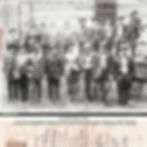Frankie Yale: The Brooklyn Don Who Taught Capone the Game
- Daniel Holland
- Jun 11
- 10 min read
Updated: Oct 11

On a warm Sunday afternoon in July 1928, the roar of engines and gunfire shattered the quiet streets of Brooklyn’s Borough Park. A sleek, coffee-coloured Lincoln coupe careened out of control, mounting the kerb before crashing into the stoop of a brick townhouse on 44th Street. Slumped at the wheel was Francesco Ioele, better known as Frankie Yale, the borough’s most feared gangster. He had been shot dead with a weapon never before used in a New York City gangland hit: the Thompson submachine gun.
Yale’s murder would send shockwaves through the underworld. It wasn’t just the brutal efficiency of the killing or the cutting-edge firepower on display, it was the identity of the man in the coffin. Yale had been more than a crime boss. He was a mentor to Al Capone, a pioneer of modern racketeering, and one of the first American mafiosi to build a truly multi-ethnic criminal enterprise. His funeral, a display of opulence and underworld respect, would be remembered for years. But in death, as in life, Yale was both feared and misunderstood.
His story, now largely relegated to the footnotes of Mafia lore, deserves closer attention, not only for its blood-soaked chapters but for what it reveals about the evolution of organised crime in 1920s America.
Early Life: From Calabria to Coney Island
Francesco Ioele was born on 22 January 1893 in Longobucco, a small mountain town in the Calabria region of southern Italy. The Ioele family, father Domenico, mother Isabella (née DeSimone), and four children, emigrated to New York around 1900, settling in one of the many crowded, immigrant-heavy tenements of Lower Manhattan. From an early age, Francesco seemed destined for something other than factory work or honest labour. He gravitated toward street life and, crucially, was taken under the wing of John Torrio, a rising figure in the notorious Five Points Gang.

Under Torrio’s guidance, young Ioele began learning the ropes of extortion, gambling, and enforcement. By 1909, after Torrio moved west to Chicago, Ioele Americanised his name to “Yale,” aligning himself with a more urbane image that would serve him well as he rose through the criminal ranks. Despite his squat, broad-shouldered frame and unassuming height, Yale quickly earned a reputation as both a skilled brawler and a calculated operator. He was arrested in 1912 on suspicion of homicide, one of many early brushes with the law that failed to slow his momentum.
Building a Criminal Empire in Brooklyn
By the 1910s, Frankie Yale had outgrown his street-level roots. Like his mentor Torrio, he understood that power came not just from muscle, but from structure, and above all, profit. Operating primarily out of Brooklyn, Yale began consolidating control over key industries that were, at the time, poorly regulated and highly susceptible to coercion. One of his earliest and most lucrative rackets was ice delivery, an essential service in a pre-refrigeration era. By offering “protection” to ice men, who were often more victims than collaborators, Yale turned an everyday necessity into a steady stream of income.

With the profits, Yale opened the Harvard Inn in 1917, a lavish bar on Seaside Walk in Coney Island. The name was more than just aspirational branding; it helped cultivate his public persona as a refined, upwardly mobile man of influence. It also became the workplace of a young Al Capone, who served as a bouncer. It was at the Harvard Inn that Capone received his now-iconic facial scars, slashed during an altercation with the brother of a woman he had insulted. After two years under Yale’s tutelage, Capone was sent to Chicago, where he joined forces with Torrio, completing a mentorship that helped shape one of the most infamous gangsters in American history.

Yale’s organisation became a prototype for the modern American Mafia. Unlike earlier Italian gangs that were tied to specific regional identities (Sicilian, Calabrian, Neapolitan), Yale’s outfit was inclusive, drawing in Italians from across the peninsula and even collaborating with non-Italian gangs if business demanded it. His operations expanded into prostitution, gambling, protection rackets for restaurants and food suppliers, and a growing bootlegging empire fuelled by the newly enacted Prohibition laws.
He was also, in an oddly entrepreneurial flourish, a cigar baron of sorts. Yale sold low-quality cigars in boxes bearing his own grinning portrait. The stogies were reputedly foul-smelling, but they were a testament to his unusual blend of vanity and marketing acumen. Simultaneously, he co-ran a funeral parlour—Uliano & Yale Funeral Home—conveniently located across from his residence. When asked what he did for a living, Yale would sometimes smirk and say, “I’m an undertaker.”
The Men Who Worked for Yale
Frankie Yale’s crew included men who would later become major figures in organised crime. Alongside Capone, he employed Joe Adonis, Anthony “Little Augie” Carfano, and Albert Anastasia, the future boss of what would become the Gambino crime family. Yale’s chief enforcer was Willie “Two-Knife” Altieri, a hitman infamous for using a blade in each hand to dispatch targets with theatrical brutality.

Though feared by his enemies and associates alike, Yale was a complicated figure in the community. He had a public image as a sharp dresser, earning him the nickname “the Beau Brummell of Brooklyn”, and was widely known for his acts of generosity. To the working-class residents of his neighbourhood, he could be counted on for a helping hand. He replaced stolen tills for shopkeepers, offered handouts to down-on-their-luck vendors, and gave unsolicited financial advice with his charity. This dual image, local benefactor and ruthless killer, only added to his legend.
A Man of Violence
Behind the charm, however, was a deep capacity for violence. When his younger brother Angelo crossed him, Yale beat him so severely that he required hospitalisation. He was known to settle scores with fists, knives, and bullets, and had little patience for disrespect. In May 1920, he is believed to have travelled to Chicago at the behest of Torrio and Capone to assassinate James “Big Jim” Colosimo, who had refused to enter the bootlegging trade. Though suspected by police, Yale was never charged, just another incident in a long trail of suspected but unproven murders.
Attacks, Ambushes, and Escalating Bloodshed
Yale’s position in Brooklyn was never entirely secure. The underworld in 1920s New York was fragmented and ferociously competitive. Traditional accounts long held that Yale was engaged in a bitter turf war with the Irish White Hand Gang over control of the Brooklyn docks. While this remains a popular narrative, more recent scholarship has suggested that Yale’s fiercest enemies were other Italian factions, each vying for dominance in a city increasingly ruled by money and blood.
On 6 February 1921, Yale and his men were ambushed in Lower Manhattan as they exited their car en route to a banquet. One bodyguard was killed, the other wounded, and Yale himself sustained a serious lung wound. He survived, but the message was clear—his position was under threat. Five months later, his car was again attacked in Bath Beach, with his brother Angelo and another man wounded. That attack was allegedly retaliation for the murder of a Manhattan gangster named Ernesto Melchiorre, killed after a visit to the Harvard Inn. Yale's men would later gun down Melchiorre's brother, Silvio, outside a café in Little Italy, fuel on the fire of ongoing vendettas.
By 1923, attempts on Yale’s life were so frequent they became almost routine. In July of that year, assassins mistook his chauffeur for him and killed the man in broad daylight as he returned from a church christening with Yale’s wife and daughters.
Murder in a Flower Shop
In November 1924, Yale was summoned once again to Chicago. Torrio and Capone, now battling for control over the Windy City’s vast bootlegging empire, needed help eliminating a dangerous rival—Dean O’Banion, the unpredictable and sharp-witted leader of the North Side Gang. On 10 November, Yale is believed to have entered the Schofield Flower Shop on North State Street with two of Capone’s men, John Scalise and Albert Anselmi. There, they shot O’Banion dead as he tended to a floral arrangement.

Yale was arrested eight days later at Union Station alongside associate Sam Pollaccia. He claimed he had come to Chicago for the funeral of Mike Merlo, the recently deceased president of the Unione Siciliana, and stayed on to visit friends. With no concrete evidence to disprove his alibi, police were forced to release him. Still, suspicion clung to him like cigar smoke, and the O’Banion killing triggered a brutal and prolonged gang war in Chicago that would claim dozens of lives, including eventually those of Scalise and Anselmi.
The Adonis Club Christmas Ambush
A year later, on 26 December 1925, Yale was once again at the centre of another infamous underworld shooting, this time back in Brooklyn. Richard “Pegleg” Lonergan, the boss of the White Hand Gang, arrived at the Adonis Club intending to disrupt Yale’s annual Christmas gathering. What followed remains murky. One version has Lonergan walking into an ambush orchestrated by Yale and Al Capone, who was visiting New York at the time while his son recovered from an ear infection. Another interpretation, supported by some contemporary accounts, suggests a spontaneous shootout sparked by a drunken insult delivered by gang member Cornelius “Needles” Ferry.
Whatever the cause, the result was carnage. Lonergan, Ferry and another man were killed, while several others were wounded. Though Capone was widely believed to have participated, no charges were ever filed. The incident signalled the collapse of the once-feared White Hand Gang and confirmed Yale’s dominance over the Brooklyn waterfront, at least for the time being.

Falling Out with Capone
By the mid-1920s, Yale was one of the most powerful men in Brooklyn. His bootlegging empire thrived, and he had made deep inroads into labour racketeering, controlling unions and dock operations. But while his position in New York was secure, his relationship with Capone was beginning to unravel.
Yale was a key supplier of Canadian whisky to Capone’s Chicago outfit. He arranged for shipments to land in New York and ensured their safe passage westward. But soon, Capone’s trucks began disappearing, hijacked before they could leave Brooklyn. Suspicious of betrayal, Capone dispatched James "Filesy" DeAmato to monitor the shipments. DeAmato reported back that Yale was behind the hijackings.
The discovery marked the end of their long association. On 1 July 1927, DeAmato attempted to kill Yale, but failed. Six days later, DeAmato was found shot dead in Brooklyn.
Capone, perhaps still feeling a sense of old loyalty, made a final gesture. He invited Yale to Chicago in September to attend the Dempsey–Tunney heavyweight title rematch at Soldier Field. The meeting was cordial, but the trust was gone. Capone returned to Chicago’s internal wars and political manoeuvres, while Yale resumed his place in Brooklyn, unaware that the final chapter of his life was being written.
The Day Brooklyn Went Quiet
On 1 July 1928, precisely one year after DeAmato’s murder, Yale received a phone call while at his Sunrise Club in Bensonhurst. The caller told him something was wrong with his wife Lucy, who was at home with their one-year-old daughter. Ignoring his associates’ offers to accompany him, Yale climbed into his new Lincoln coupe, a custom vehicle with armour plating. Unfortunately for him, the windows had not been bulletproofed.
As he drove north on New Utrecht Avenue, a dark Buick sedan pulled alongside him. Inside were four men armed with pistols, a shotgun, and a Thompson submachine gun. When the light changed, Yale accelerated, but the Buick kept pace. As they turned onto 44th Street, the gunmen opened fire. A shotgun blast hit Yale in the side of the head. Moments later, a burst from the Tommy gun tore through his skull. Either wound would have been fatal.
Yale’s car veered off the road, mounted the pavement, and crashed into the steps of a brownstone at 923 44th Street. It was the first recorded use of a Thompson submachine gun in a New York gangland killing.

The Funeral of the Decade
In death, Yale received one of the grandest send-offs the American underworld had ever seen. His silver casket, reportedly worth $15,000, was laid out in state. He was dressed in formal evening wear, a gold rosary wrapped around his fingers and grey suede gloves resting on his chest. A diamond ring adorned one hand; a belt buckle bearing his initials, made with 75 tiny diamonds, was fastened at his waist. It was said Capone had gifted the buckle to those he respected most.

The funeral procession stretched for blocks. Thirty-eight cars were required to carry the floral arrangements. Over 250 black Cadillacs transported mourners, and thousands of Brooklyn residents lined the streets to witness the spectacle. As his casket was lowered into the ground at Holy Cross Cemetery, two women stepped forward to claim they were his widow. At the graveside, 112 mourners dropped roses into the open grave.
Legacy and the Road to the Castellammarese War
In the weeks following the murder, police found the Buick abandoned just blocks from the scene. Inside were several weapons, including the Tommy gun later linked to the 1929 St. Valentine’s Day Massacre in Chicago. The car itself was traced to Knoxville, Tennessee; the guns to a dealer in Chicago named Peter von Frantzius. Capone was questioned multiple times but never charged. The killers were never positively identified, though speculation centred on Capone’s hitmen—Tony “Joe Batters” Accardo, Fred “Killer” Burke, Gus Winkler, George “Shotgun” Ziegler, and Louis “Little New York” Campagna.
Yale’s criminal empire did not vanish with him. It was quickly carved up: half passed to his lieutenant Anthony “Little Augie” Carfano, the other half absorbed by the former D’Aquila crime family, now under the leadership of Al Mineo. Joe Masseria soon seized the moment to orchestrate the murder of D’Aquila himself, consolidating power and nudging New York towards all-out Mafia civil war. The December 1928 Hotel Statler meeting in Cleveland was called, in part, to avoid a repeat of the violence sparked by Yale’s murder, but the effort failed.
The resulting struggle, known as the Castellammarese War, would claim dozens of mobsters and reshape the American Mafia. Yale’s killing, in many ways, marked the beginning of this bloody new era.
Sources
Lacey, Robert. Little Man: Meyer Lansky and the Gangster Life. Little, Brown, 1991.
Sifakis, Carl. The Mafia Encyclopedia: From Accardo to Zwillman. Facts on File, 2005.
Reppetto, Thomas. American Mafia: A History of Its Rise to Power. Henry Holt, 2004.
English, T.J. The Westies: Inside New York’s Irish Mob. St. Martin’s Press, 1990.
Eig, Jonathan. Get Capone: The Secret Plot That Captured America’s Most Wanted Gangster. Simon & Schuster, 2010.
Landesman, Fred. Frankie Yale: Brooklyn Gangster. Gangland Press, 1997.
Kobler, John. Capone: The Life and World of Al Capone. Da Capo Press, 1971.
Critchley, David. The Origin of Organized Crime in America: The New York Mafia, 1891–1931. Routledge, 2008.
FBI: The Vault – Organized Crime Files (Frankie Yale, Al Capone).
New York Times archives (1928): coverage of Yale’s murder and funeral.
Brooklyn Daily Eagle archives: reports on Yale’s business interests and police investigations, 1919–1928.
Raab, Selwyn. Five Families: The Rise, Decline, and Resurgence of America’s Most Powerful Mafia Empires. St. Martin’s Press, 2005.
Crime Magazine – “The Murder of Frankie Yale,” 2014.
Smithsonian Magazine – “How Prohibition Built the American Mob,” 2018.
Chicago Tribune archives – references to Capone’s early years working under Yale in Brooklyn.






















